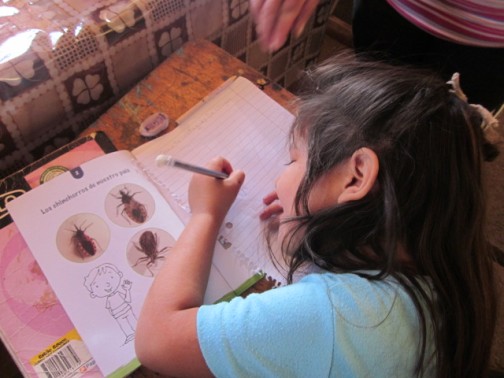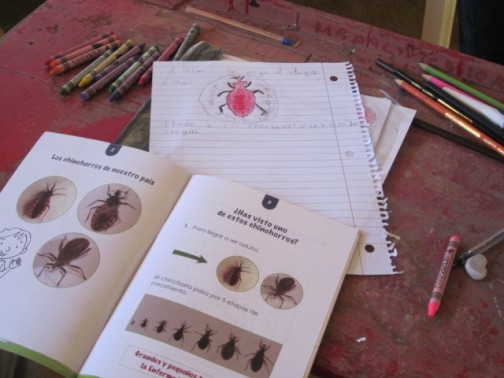|
Friday the thirteenth, the day we were all expecting with a strange mix of excitement and dread. We were super excited about Healthy Living’s open house. The open house was HL’s closing event, where we would be showcasing what the team and the community members had been working on together for the past few weeks. On the other hand we were dreading two things: the bad luck of a Friday the 13th- which fortunately waited until the event was finished to manifest- and, more than anything, we dreaded the thought of having to say goodbye to the people of Chaquizhca, Guara and Bella Maria. People who had so warmly opened their homes, schools, and their hearts to us. We arrived very early in the morning to set everything up, gosh I had like 300 drawings from the story telling and participatory project I was working on at the local schools. Lucky for me the children arrived shortly and came to my rescue. Later, some folks from our french ally institution Tsiky Tzanaka joined in, and we were done in the nick of time. The party started at around 10 in the morning, it was the perfect mix of a cultural fair and a gathering between good friends. There were booths with local produce and crafts, others with some creative work from the members of the HL team, and some from local partners and institutions. There were interactive activities like the solar clock, which aimed to show community members traditional alternatives to new technologies that have been forgotten; the family photo booth and community photo shows; the balance and jumping ropes for the children. I was in charge of the children’s room, where the drawings from the story telling and participatory sketching activities were showcased, along with art projects from the children’s class work. It was a very nice experience, having people come and explaining what the children and I had worked on for the entire month, why it was relevant and what was next. Later on, there were performances from the children and community members. The best moment for me was when I found out the community members had set up a snack post with traditional Latin-American delights like empanadas and salchi-papas (fries and wienies); I always loved those back in Colombia and had missed them a lot. We concluded the event with a nice lunch and warm goodbyes. The children asked me “Lily, Lily!!! are you coming back next year?” I smiled cautiously and answered “God willing, I will try ” I was sad about the uncertainty of it all, but I felt worse about people who were probably asked the same question, but knew for sure they were not coming back. Still, whether we planned on coming back or not, we hoped that the communities had found our presence as enjoyable as we had found their company, and that our work had impacted their lives at least half as much as it did our souls. Going home, Friday the 13th started kicking in: two vans had flat tires, we encountered all kinds of crazy stuff on the road, but at the end of the day there was nothing but satisfaction in the memory of that day. As we shared dinner and drinks we also shared warm and happy memories, funny anecdotes and jokes about some not so pleasant experiences. The open house had closed, but we hope that the hearts we tried to reach during our time there would remain open. Apart from the display of children’s drawings, there are also other booths of Clinic, Entomology, Mammal, Entomology, Healthy Living, and some agriculture products and souvenirs bought to the Open House by local people. Let’s see what we have for the day. Link to the original post: http://oueduabroad.wordpress.com/2012/07/27/open-houses-open-hearts-and-bitter-sweet-farewells/ |















































 The schools’ teachers were very enthusiastic about these activities since, as one of them stated, “they help the kids create and reflect at the same time, instead of reading and memorizing things” and all of them said they would be interested in incorporating this kind of activity into their curriculum. I’d like to pretend to be a very noble person and say I’m working hard to make a difference , but truth to be told I’m just having fun . Gosh I’m so lucky! I get to play like a little kid and call it a work day 😉
The schools’ teachers were very enthusiastic about these activities since, as one of them stated, “they help the kids create and reflect at the same time, instead of reading and memorizing things” and all of them said they would be interested in incorporating this kind of activity into their curriculum. I’d like to pretend to be a very noble person and say I’m working hard to make a difference , but truth to be told I’m just having fun . Gosh I’m so lucky! I get to play like a little kid and call it a work day 😉
